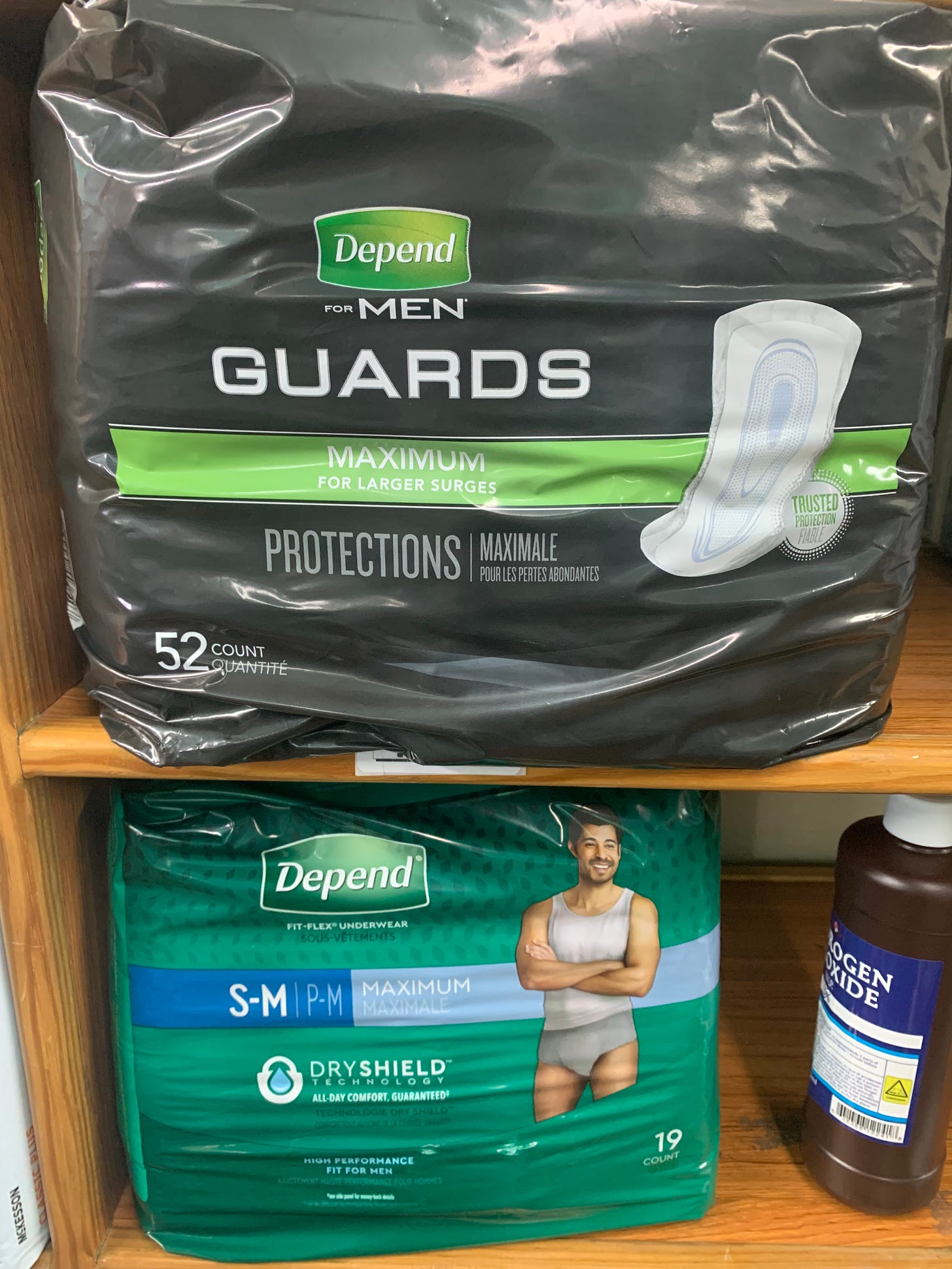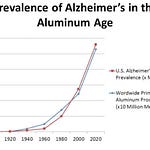If you sit and watch the TV in the US for a few hours, you will be subjected to ads showing tough-looking men in their 60s proudly sporting padded crotches. These are explained not as codpieces for macho dudes with young mistresses but as “male incontinence garments.” Diapers, in other words.
We all know the story: many women lose urine as they age; their “pelvic walls” were stretched by childbirth. But men have prostate enlargement and tend to get blockage rather than leakage. What is this marketing about “protection” for them? And how can these pads possibly be a $4 billion US industry?
Various conditions, such as Parkinson’s Disease, can produce male incontinence, but the most common cause is a routine complication of “radical prostatectomy” surgery. This procedure should almost never be performed and the numbers prove it. I tell the story in Butchered by “Healthcare:”
THE PROSTATE CANCER MEAT GRINDER
Every great cause begins as a movement, becomes a business, and eventually degenerates into a racket.
Eric Hoffer
Urology’s approach to [prostate cancer] has undergone an embarrassing outing. The specialty traditionally recommends that the surgeon draw blood for prostate-specific antigen (PSA). The urologists also insert their finger into the patient's rectum to feel for prostate lumps.
If the blood test is high, or the surgeon feels nodules, they stick a large needle repeatedly through the rectum into the prostate to get tissue samples. If the biopsy shows cancer, urologists recommend perilous surgeries or other alarming therapies. This system has been discredited because it never improved survival rates for early disease.
The cancer is present but inactive in most men over 50. Only about twelve percent of men will be diagnosed with prostate cancer during their lives, and their five-year relative survival rate for this cancer after it is diagnosed (the percent with the disease who are alive compared to matched controls) is 97.8 percent. Ignoring it in the early stages produces the same results as treatment, but without the horrific surgical complications. The commonly performed operation, a radical prostatectomy, causes death in 1/200. Compromised or ruined sexuality and uncontrollable urination requiring diapers are common, often for the rest of a man’s life.
Some patients already have metastatic cancer before surgery. In these cases, it kills the patient even though he has suffered through the grisly procedure and recovery.
The PSA test is unreliable. It increases with any irritation of the gland due to factors such as infection or even bicycle riding. Antibiotics or anti-inflammatories are the treatments, not surgery. The vast majority of these tumors grow so slowly that death occurs from something else before the disease becomes an issue. PSA is little help to identify aggressive cancers that would be fatal.
Here is a little math: The USPSTF (US Preventive Services Task Force) did a large-scale analysis of the research literature. They concluded that for every 1,000 men ages 55 to 69 who had their PSA checked every one to four years for a decade, it would save one man from prostate cancer. The number needed to test is 1000, over 10,000 patient-years, and who knows how many tests, possibly 50,000.
Even if you believe these small numbers are meaningful, the cost-benefit ratio is terrible. False-positive PSAs lead to biopsies, which have complications just like the true positives. Men with biopsies that show cancer get surgery or other treatments. The harms resulting from these interventions include erectile dysfunction, urinary incontinence, serious cardiovascular events, deep vein thrombosis, pulmonary embolism, and occasionally death. Checking PSA in asymptomatic men produces no improvement in survival.
The American Veterans Administration “PIVOT” trial compared surgery versus observation for localized prostate cancer over 13 years. There was no statistically or clinically significant difference in either all-cause (absolute survival) or even disease-specific mortality (relative survival). Prostate removal surgery is a net harm.
A Scandinavian study looked at 695 men with prostate cancer. They were divided into two groups. One had radical prostatectomy surgery, the other “watchful waiting.” With the surgery, the men were half as likely to die of the cancer (relative death rate). Their overall death rates from all causes (absolute deaths) at five and ten years were identical to those who did not have the surgery. Other researchers support these results.
By 2013, urologists partially responded to the heckling from the rest of the medical community. Their new guidelines recommended “individualizing” this test using “shared decision making” between physicians and patients for ages 55 to 69. This is misguided. Otis Brawley, head of the American Cancer Society until 2018, told the story of an unfortunate patient who was victimized by this system in his book How We Do Harm (2012):
Ralph entered the prostate cancer meat-grinder after he had his PSA drawn in a shopping mall at a free cancer screening event. It was 4.3. He had twelve painful biopsies. Two of them showed a moderate grade cancer in about fifteen (15) percent of each specimen. Ralph read everything he could. He decided on robotic surgery because the advertising said it was “advanced.” It left him impotent and incontinent, and he required diapers for the rest of his life. His PSA several months later was .9. It would have been zero if the surgeon had entirely removed his prostate. He became obsessed with the idea that he still had cancer. So he went to a radiation oncologist who obligingly treated him with “proton beam therapy.” When he began seeing blood in his stools later, his surgeons found a fistula. This is a connection between his urethra (urine tube) and his bowel. It was confirmed when he began passing bowel gas from his penis. The surgeons treated him by sewing his colon to the front of his abdomen with a “colostomy,” which required him to change a bag containing his stool several times a day. They also created a similar passage from his bladder to his belly, a urostomy. He still had both when he died of a severe urinary infection a few years later. He was 72.
The urologists, or at least the male ones, do not seem to understand the PSA math. Eighty percent of them, along with half the internal medicine specialists, continue to test their own PSAs. Patients have little chance of understanding any of this if most physicians do not.
Like other diseases with expensive treatments, the prostate cancer industry has nonprofit “advocacy” associations growing in a dense thicket all around it. These universally promote PSA screening, which starts the cascade of billions of dollars of medical services. One organization, Us TOO, is 90 percent funded by the pharmaceutical and device companies that profit from this prostate circus. Zero, formerly the National Prostate Cancer Coalition, has funding from Amgen, AstraZeneca, Aventis, Cytogen, Merck, Pharmacia, and Pfizer.
Kimberly-Clark, the maker of Depends incontinence diapers, is another donor. Prostate cancer surgery sells a lot of adult diapers for them. Zero and the others claim to be independent, unbiased grassroots groups that are not beholden to any company.
Shared decision-making is an abdication of responsibility. We are losing trust in advisers who cannot advise. Fewer and fewer will shoulder responsibility in this age of lawsuits. Other People’s Money, a book about finance, explains the issue: “A good lawyer manages our problem; a bad lawyer responds to every issue by asking us what we want to do. When ill, we look for a recommended course of action, not a detailed description of our ailments and a list of references to relevant medical texts. The demand for transparency in finance is a symptom of the breakdown of trust.”
I recommend men pretend they do not have a prostate unless they get symptoms. (Disclaimer: I am not a prostate specialist. There may be advantages to these treatments that I did not find. Prostate cancer therapy has common themes with the rest of medicine, however. It is complex and there are conflicts of interest. The treatment studies have large numbers, small differences, and outsize claims.)
Many men cannot wrap their heads around the idea that they should not allow urologists to mess with their prostate. If you still do not get it and you think that there is merit in identifying prostate cancer at an early stage, consider magnetic resonance imaging (MRI) and, if necessary, laser treatment by a radiologist. These are currently the least invasive test and therapy. If the MRI shows a tumor is likely, an imaging specialist can put a guided sampling needle into the suspicious area(s). This results in a diagnosis rate of 90 percent after only one or two sticks.
Contrast this with the usual dozen “random” biopsies that discover only about half of the cancers. You are left sore and in limbo, anticipating a new round of biopsies a year later. Or, if you received a cancer diagnosis, you have to start considering radiation or horrifying, ineffective surgery on your most private parts.
With MRI guidance, however, a laser can be used accurately to burn tiny spots of cancer. You do not get complications from surgery or radiation you never have. Only a few centers in the USA offer this expensive but safe and accurate method. These include Desert Medical Imaging (now Halo Diagnostics) in Palm Springs, CA, and with affiliates nationwide. They also offer a non-invasive treatment for benign prostatic hypertrophy using this same technology.
Since radical prostatectomy for prostate cancer is a multi-billion-dollar surgical industry, these radiologists receive a brutal reception at urological surgery meetings and are not allowed to speak. But the standard approaches are outdated, deforming, require years of care, and the math does not support them.
Note well: all of these therapies are doubtful because the radiologists, like the surgeons, mostly treat low-grade prostate cancer, which rarely kills anyone. Since I can do without needles stuck in my tender places, I refuse to check my PSA ever again unless I have symptoms.
Prostate cancer that has spread or metastasized outside the gland is a different issue. This has been treated effectively and inexpensively using synthetic estrogen for more than 50 years. Some doctors still do this. Bio-identical estradiol is available now and should be used instead of the older estrogen compounds. For many patients, this suppresses the tumor, and they feel fine. The PSA should be checked at intervals to be sure.
Casodex and Lupron are the patented, expensive anti-testosterone drugs that are the current “standard of care” for metastatic prostate cancer treatment. They typically work for about five years, then cancer comes back. They cause heart disease, Alzheimer’s, osteoporosis, and make patients feel terrible. There is speculation that they produce more deaths than they prevent—recall the Hormone Blockers Ruin Health chapter.
PS: I had a lot of praise about the Ken Stoller interview.
"That was a jam-packed fascinating interview. I hope you do at least one more with Dr. Stoller. Will be sharing."
"So informative...and wow, the connection between vaccines and is well outlined...as a mater of fact, between all diseases for which no $$ drugs could help enormously..."
HERE is another one if you want more. Passcode: g1*+aP&%
The Cassandra's Memo ebook is free HERE if you promise to send this download link to five or more others. With your help, we will educate some people sitting on the fence. If you have time to write a review at Barnes and Noble, click HERE and scroll down the page until you see the blue “review” button on the right.
BONUS: I am also giving away the Hormone Secrets and Butchered by "Healthcare" ebooks using the same arrangement; you can download them free HERE and HERE if you promise to send the links to your friends.
We are in an information war. As Peter McCullough says, once someone sees, they cannot unsee. You are drafted—but only if you give a damn—to start a Substack, upload your entire phone list, then mail them every week as I suggested HERE in “Your Conscription Notice Into the Revolutionary Army.” You have something to say, and even if you doubt that, you should copy and send out the words of others. If you think this is too much work, contemplate what it was like at Valley Forge during the Revolutionary War. You may soon find yourself in a situation like that.
Substack Love
















Share this post